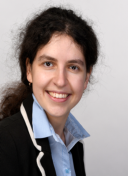 In this thesis experimental and theoretical tools are defined, to connect phosphor powder properties to the colour point of white LEDs.
In this thesis experimental and theoretical tools are defined, to connect phosphor powder properties to the colour point of white LEDs.
‘I was really surprised a systematic study didn’t already exist,’ says Maryna Meretska. ‘Despite the fast-growing market penetration, there are currently only trial and error approaches for white LED modelling.’
Maryna proposed and experimentally verified a novel approach, that fully describes light diffusion and emission in phosphor layers. Maryna’s findings are of great practical use for designing LED applications. ’The design efficiency is increased,’ she says. ‘Recurring design efforts can be avoided, thus decreasing the cost of ownership of white LED units worldwide.’
In her approach, analytical methods are allowed to be widely used. A large design parameter space is enabled. For example, a look-up table can be created where the phosphor type will be mapped, to the area of all possible colours it can generate.
Maryna: ‘Application of the described approach, will provide the physical connection to the design parameters of a white LED, in order to produce the desired colours.’
Phosphor particles inside a diffuser layer scatter, absorb and re-emit light of a white LED. ‘Absorption and scattering both affect the light strongly,’ Maryna says. ‘This is an exotic regime of light transport. I was extremely lucky to find myself working on this research topic, finding fundamental and practical relevant insights alike.’
Measurement techniques
In this project experimental work and theoretical exercises alternated, leading to a strong central theoretical framework, describing light propagation in scattering materials with strong absorption.
‘Conventional measurement techniques failed to provide a separation, between scattering properties of the materials and broadband re-emission,’ Maryna says. ‘Therefore, I performed measurements in the range where scattered and re-emitted light are spectrally separated. Even more so, I presented a novel experimental setup using narrowband illumination. Here, the scattered and re-emitted light are always separated, and can be distinguished.’
‘Regarding the challenging experiments, I owe a lot to my supervisor, Professor Willem Vos, leader of the Complex Photonics Systems (COPS) Group. He taught me that small but crucial things are decisive, in order to make challenging experiments work.’
P3 and P1
Theoretically, two approximations (P3 and P1) were tested, both derived from the more general radiative transfer equation (RTE).
Maryna: ‘The first order approximation (P1) was found reasonably good already, giving an error of the order of 30%, but not being applicable to some scattering materials. We theoretically identified the applicability range of the P1 approximation, and decided to switch to the P3 approximation. By performing more sophisticated experiments, a wider parameter space was identified. The P3 approximation was used to analyse the experimental data.’
‘P3 can be used for scattered and re-emitted light, to analytically predict the spectrum of a white LED. At last, I demonstrated that the colour point of a white LED can be reversibly tuned without changing its design. It describes the light propagation in complex geometries that is regularly employed in white LED’s design.’
Publications
Maryna: ‘During the third year of my PhD, everything started to fall into place, allowing me to concentrate on my writings. This resulted in publications, in Optics Express and Applied Physical Letters. More papers are under admission at this very moment. As a post-doc, I am now working, for a few extra months, on some smaller, related subjects.’
Collaboration
During the PhD project, Maryna enjoyed collaborating with experts from Philips Research. ‘This collaboration was very close. We contacted each other very frequently,’ she says. ‘Our findings are of practical use for them. These findings are published in scientific journals. In my opinion industrial collaboration doesn’t hamper the ability to publish scientific results. As a matter of fact, physics cannot be patented.’
Future job
Maryna believes her future job could well be in academics as in industry. ‘At this moment, I favour an academic career, as I like to see progress in understanding. I am now applying for an interesting post-doc as well as for industrial positions, be it in the US, Australia or Canada,’ she says. ‘Still young, allows me to freely choose learning new things in a new culture. Like I did here in Twente. I enjoyed being a member of COPS, a friendly and open Group. During coffee breaks we always had dynamic discussions, be it on physics or on world politics.’
‘Also, I learned to present my research, explaining and convincing others of my results and my research field - using pictures to illustrate the equations and physics towards a broader audience, in a simple and lively manner. This feature of scientific work is often overlooked in my home country Ukraine. Learning these skills made me a more communitive and open person. That helps in everything.’
